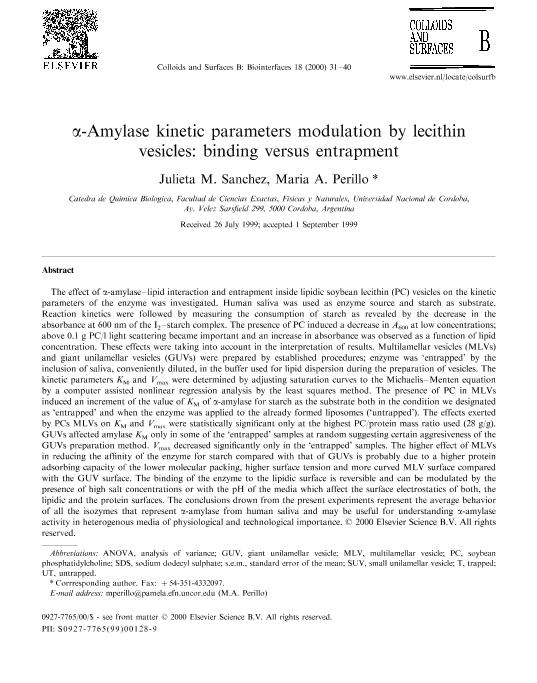Artículo
α-Amylase kinetic parameters modulation by lecithin vesicles: Binding versus entrapment
Fecha de publicación:
15/06/2000
Editorial:
Elsevier Science
Revista:
Colloids and Surfaces B: Biointerfaces
ISSN:
0927-7765
Idioma:
Inglés
Tipo de recurso:
Artículo publicado
Clasificación temática:
Resumen
The effect of α-amylase-lipid interaction and entrapment inside lipidic soybean lecithin (PC) vesicles on the kinetic parameters of the enzyme was investigated. Human saliva was used as enzyme source and starch as substrate. Reaction kinetics were followed by measuring the consumption of starch as revealed by the decrease in the absorbance at 600 nm of the I2-starch complex. The presence of PC induced a decrease in A600 at low concentrations; above 0.1 g PC/l light scattering became important and an increase in absorbance was observed as a function of lipid concentration. These effects were taking into account in the interpretation of results. Multilamellar vesicles (MLVs) and giant unilamellar vesicles (GUVs) were prepared by established procedures; enzyme was 'entrapped' by the inclusion of saliva, conveniently diluted, in the buffer used for lipid dispersion during the preparation of vesicles. The kinetic parameters K(M) and V(max) were determined by adjusting saturation curves to the Michaelis-Menten equation by a computer assisted nonlinear regression analysis by the least squares method. The presence of PC in MLVs induced an increment of the value of K(M) of α-amylase for starch as the substrate both in the condition we designated as 'entrapped' and when the enzyme was applied to the already formed liposomes ('untrapped'). The effects exerted by PCs MLVs on K(M) and V(max) were statistically significant only at the highest PC/protein mass ratio used (28 g/g). GUVs affected amylase K(M) only in some of the 'entrapped' samples at random suggesting certain aggresiveness of the GUVs preparation method. V(max) decreased significantly only in the 'entrapped' samples. The higher effect of MLVs in reducing the affinity of the enzyme for starch compared with that of GUVs is probably due to a higher protein adsorbing capacity of the lower molecular packing, higher surface tension and more curved MLV surface compared with the GUV surface. The binding of the enzyme to the lipidic surface is reversible and can be modulated by the presence of high salt concentrations or with the pH of the media which affect the surface electrostatics of both, the lipidic and the protein surfaces. The conclusions drown from the present experiments represent the average behavior of all the isozymes that represent α-amylase from human saliva and may be useful for understanding α-amylase activity in heterogenous media of physiological and technological importance. Copyright (C) 2000 Elsevier Science B.V.
Archivos asociados
Licencia
Identificadores
Colecciones
Articulos(IIBYT)
Articulos de INSTITUTO DE INVESTIGACIONES BIOLOGICAS Y TECNOLOGICAS
Articulos de INSTITUTO DE INVESTIGACIONES BIOLOGICAS Y TECNOLOGICAS
Citación
Sanchez, Julieta Maria; Perillo, Maria Angelica; α-Amylase kinetic parameters modulation by lecithin vesicles: Binding versus entrapment; Elsevier Science; Colloids and Surfaces B: Biointerfaces; 18; 1; 15-6-2000; 31-40
Compartir
Altmétricas




